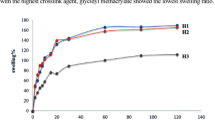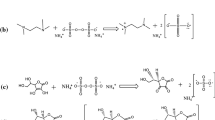Abstract
Purpose. To study the release of macromolecules of different sizes (bovine serum albumin, immunoglobulin G) from degrading (addition of dextranase) dextran methacrylate (dex-MA) hydrogels and to correlate the release with the evolution of the rehologic properties of the hydrogels during degradation.
Methods. The size of the macromolecules, the degree of substitution (i.e., number of methacrylates per 100 glycopyranose residues) of the dex-MA and the dextranase concentration in the hydrogels was varied. The rheologic properties were measured with a controlled stress rheometer.
Results. The release from dex-MA hydrogels without dextranase was very small [7-20% (time frame up to 180 days)] showing that most of the molecules were entrapped within the hydrogel network. The release from degrading dex-MA hydrogels followed zero-order kinetics for all molecules during a substantial period of the release. This was explained by a liberation and an increasing diffusivity of the proteins in the course of the degradation. The total amount released and the release rates could be well correlated with the rheologically observed degradation rates.
Conclusions. It was shown that rheology can be a useful tool to help explain the release from degrading hydrogels.
Similar content being viewed by others
REFERENCES
N. Vyavahare and J. Kohn. Photocrosslinked hydrogels based on copolymers of poly(ethylene glycol) and lysine. J. Polymer Sci. 32:1271-1281 (1994).
B. Amsden. Solute diffusion within hydrogels: mechanisms and models. Macromolecules 31:8382-8395 (1998).
B. Amsden. An obstruction-scaling model for diffusion in homogeneous hydrogels. Macromolecules 32:874-879 (1999).
S. Lu and K. S. Anseth. Release behavior of high molecular weight solutes from poly(ethylene glycol)-based degradable networks. Macromolecules 33:2509-2515 (2000).
W. E. Hennink, O. Franssen, W. N. E. Van Dijk-Wolthuis, and H. Talsma. Dextran hydrogels for the controlled release of proteins. J. Control. Release 44:107-114 (1997).
O. Franssen, O. P. Vos, and W. E. Hennink. Delayed release of a model protein from enzymatically degrading dextran hydrogels. J. Control. Release 44:237-245 (1997).
W. N. E. Van Dijk-Wolthuis, O. Franssen, H. Talsma, M. J. Van Steenbergen, J. J. Kettenes-Van Den Bosch, and W. E. Hennink. Synthesis, characterization and polymerization of glycidyl methacrylate derivatized dextran. Macromolecules 28:6317-6322 (1995).
W. N. E. Van Dijk-Wolthuis, J. J. Kettenes-Van Den Bosch, A. Van der Kerk-Van Hoof, and W. E. Hennink. Reaction of dextran with glycidyl methacrylate: an unexpected transesterification. Macromolecules 30:3411-3414 (1997).
W. E. Hennink, H. Talsma, J. C. H. Borchert, S. C. DeSmedt, and J. Demeester. Controlled release of proteins from dextran hydrogels. J. Control. Release 39:47-55 (1995).
M. Bradford. A rapid and sensitive method for the quantification of microgram quantities of protein using the principle of protein-dye binding. Anal. Biochem. 72:248-254 (1976).
T. K. L. Meyvis, S. C. DeSmedt, W. E. Hennink, and J. Demeester. Rheological monitoring of long-term degrading hydrogels. J. Rheol. 43:933-950 (1999).
S.-H. Kim and C.-C. Chu. Pore structure analysis of swollen dextran methacrylate hydrogels by SEM and mercury intrusion porosismetry. J. Biomed. Mater. Res. 53:258-266 (2000).
W.-Y. Kuu, R. W. Wood, and T. J. Roseman. Factors influencing the kinetics of solute release. In A. Kydonieus (ed.), Treatise on Controlled Drug Delivery, Marcel Dekker, New York, 1992 pp. 37-154.
N. J. Chang and K. J. Himmelstein. Dissolution-diffusion controlled constant-rate release from heterogeneously loaded drug-containing materials. J. Control. Release 12:201-212 (1990).
W. N. E. Van Dijk-Wolthuis, S. K. Y. Tsang, M. J. Van Steenbergen, C. Hoogeboom, and W. E. Hennink. Degradation and release behaviour of dextran based hydrogels. Macromolecules 30:4639-4645 (1997).
S. C. De Smedt, T. K. L. Meyvis, J. Demeester, P. Van Oostveldt, J. C. G. Blonk, and W. E. Hennink. Diffusion of macromolecules in dextran methacrylate solutions and gels as studied by confocal scanning laser microscopy. Macromolecules 30:4863-4870 (1997).
O. Franssen, R. D. Van Rooijen, D. DeBoer, R. A. A. Maes, and W. E. Hennink. Enzymatic degradation of crosslinked dextrans. Macromolecules 32:2896-2902 (1999).
J. D. Ferry. Viscoelastic Properties of Polymers, John Wiley & Sons, New York, 1980.
T. K. L. Meyvis, S. C. De Smedt, W. E. Hennink, and J. Demeester. Influence of the degradation mechanism of hydrogels on their elastic and swelling properties during degradation. Macromolecules 33:4717-4725 (2000).
Author information
Authors and Affiliations
Rights and permissions
About this article
Cite this article
Meyvis, T., De Smedt, S., Stubbe, B. et al. On the Release of Proteins from Degrading Dextran Methacrylate Hydrogels and the Correlation with the Rheologic Properties of the Hydrogels. Pharm Res 18, 1593–1599 (2001). https://doi.org/10.1023/A:1013038716373
Issue Date:
DOI: https://doi.org/10.1023/A:1013038716373




